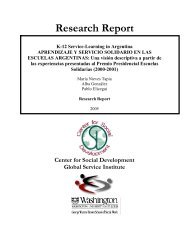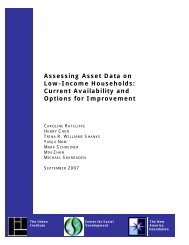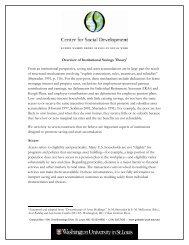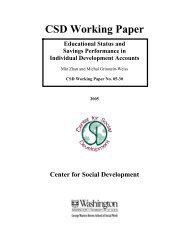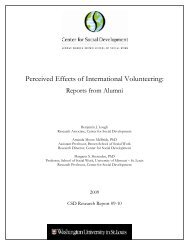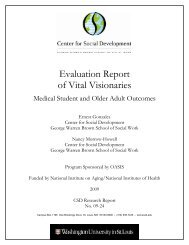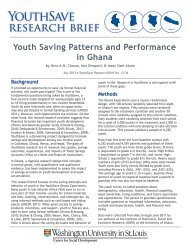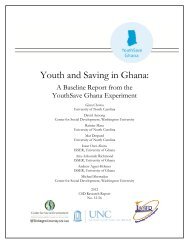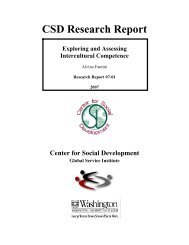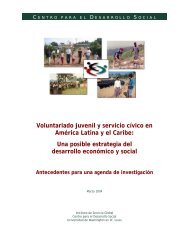Rediscovering social investment in developmental welfare state ...
Rediscovering social investment in developmental welfare state ...
Rediscovering social investment in developmental welfare state ...
Create successful ePaper yourself
Turn your PDF publications into a flip-book with our unique Google optimized e-Paper software.
R E D I S C O V E R I N G S O C I A L I N V E S T M E N T I N D E V E L O P M E N T A L W E L F A R E S T A T E P O L I C I E S :<br />
B A C K T O T H E F U T U R E<br />
agent <strong>in</strong> family decisions. 55 Family members who work <strong>in</strong> the market will compensate those who<br />
specialize <strong>in</strong> household production dur<strong>in</strong>g the childrear<strong>in</strong>g phase and later <strong>in</strong> life, which postulates a<br />
permanent, unanimous family (Lundberg, 2002).<br />
Economists typically approach the labor market from a simplified perspective that assumes perfect<br />
competitiveness, where <strong>in</strong> the absence of laws workers and employers have perfect <strong>in</strong>formation,<br />
transaction costs are absent, and workers—choos<strong>in</strong>g to maximize their utility function (<strong>in</strong>come or<br />
leisure)—earn their marg<strong>in</strong>al product of labor. These assumptions are then relaxed, deviations from<br />
perfectly competitive labor markets are considered, <strong>in</strong>clud<strong>in</strong>g that there are costs associated with<br />
employment and switch<strong>in</strong>g jobs. ALMPs or measures to improve the function<strong>in</strong>g of the labor<br />
market that are directed towards the unemployed (Calmfors, 1994) come from a recognition of<br />
imperfections <strong>in</strong> the labor market. For example, workers have <strong>in</strong>sufficient <strong><strong>in</strong>vestment</strong> <strong>in</strong> skills<br />
because they are severely credit constra<strong>in</strong>ed. Firms are not will<strong>in</strong>g to f<strong>in</strong>ance general qualifications<br />
(Becker, 1962, 1964) and will only <strong>in</strong> part pay the expenditures for develop<strong>in</strong>g firm-specific skills.<br />
Thus, the ma<strong>in</strong>stream approach favors better loan markets over direct subsidies to tra<strong>in</strong><strong>in</strong>g<br />
(Acemoglu & Pischke, 1999) and sees little role for ALMP. Heckman et al. (1999, p. 2080) conclude<br />
that ―when effective, ALMPs make economically disadvantaged persons less poor and modestly<br />
<strong>in</strong>crease employment among the unemployed, however, these ga<strong>in</strong>s (if present) are small and it is<br />
unlikely that a substantial <strong>in</strong>crease <strong>in</strong> government fund<strong>in</strong>g will improve work force skills.‖ Economic<br />
theory provides little clear guidance to the effect of labor <strong>in</strong>stitutions on economic performance<br />
(Freeman, 2008). 56<br />
The neoclassical view on <strong>social</strong> policy suggests that maximum economic efficiency should result<br />
from low overall <strong>social</strong> policy expenditures, as limitations on the budgets would serve to keep taxes<br />
and labor dis<strong>in</strong>centives low. In this view, these policies comb<strong>in</strong>ed with the economic efficiency that<br />
results should lead to low <strong>in</strong>come poverty <strong>in</strong> the long term. Further, ma<strong>in</strong>stream economists tend<br />
not to consider the multidimensionality and potentially complex <strong>in</strong>teractions associated with how<br />
<strong>social</strong> policies are comb<strong>in</strong>ed.<br />
I argued earlier that <strong>developmental</strong>ist <strong>social</strong> policy focused on <strong>in</strong>-k<strong>in</strong>d benefits, nonmeans-tested<br />
benefits, family expenditures and ALMP, and higher levels of expenditures. I briefly discuss these<br />
aspects aga<strong>in</strong>, highlight<strong>in</strong>g the economic logic that leads to these policy directions. Accord<strong>in</strong>g to<br />
<strong>in</strong>clusive <strong>welfare</strong> <strong>developmental</strong>ism, <strong>in</strong>-k<strong>in</strong>d benefits are advantageous because they guarantee<br />
consumption of <strong>developmental</strong>ly-relevant goods and services, facilitate political support by the<br />
nonpoor (so are likely to be more adequate and accessible), are less likely than cash to be wasted by<br />
people, and are less likely to generate moral hazard. Economists see cash as important because<br />
parents prefer cash transfers over <strong>in</strong>-k<strong>in</strong>d <strong>in</strong> that they can spend them as they see fit. In contrast,<br />
55 In the context of a unitary household, gender equality <strong>in</strong> command over resources need not require equality <strong>in</strong> market<br />
wages or earn<strong>in</strong>gs opportunities. In this view, if specialization <strong>in</strong> the household is efficient due to comparative advantage<br />
or sector-specific learn<strong>in</strong>g, it will also be <strong>social</strong>ly desirable. S<strong>in</strong>ce childrear<strong>in</strong>g takes up only a portion of the total lifespan<br />
but tends to co<strong>in</strong>cide with a period when <strong>in</strong>tense <strong><strong>in</strong>vestment</strong>s <strong>in</strong> market skills are optimal for workers, an efficient family<br />
solution will <strong>in</strong>volve some <strong>in</strong>tertemporal redistribution.<br />
56 Perhaps a central reason for this is the possibility that ―<strong>in</strong>stitutions that work <strong>in</strong> one way <strong>in</strong> one country may work<br />
differently <strong>in</strong> another because the rest of the <strong>in</strong>stitutional structure differs‖ (Freeman, 1998, p. 6). Freeman notes that<br />
too little is known about how labor <strong>in</strong>stitutions fit together as systems. A system exists when the contribution of one<br />
<strong>in</strong>stitution to outcomes depends on the configuration of other <strong>in</strong>stitutions. Complementarity among labor and other<br />
practices is where policies may be productive whereas absent the other <strong>in</strong>stitutions, they may be less productive or even<br />
counterproductive.<br />
C E N T E R F O R S O C I A L D E V E L O P M E N T<br />
W A S H I N G T O N U N I V E R S I T Y I N S T . L O U I S<br />
38



